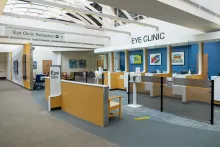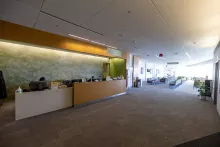Cataract Surgery Clinic
- For all other requests:
- 1-800-777-8442
The clinic evaluates and treats patients with all types of cataracts:
- Age-related cataracts: Related to aging
- Congenital cataracts: Some babies are born with cataracts or develop them during childhood, often in both eyes. Some congenital cataracts do not affect vision, but others do and need to be removed
- Secondary cataracts: Develop primarily as a result of another disease (e.g., diabetes) or some drugs such as steroids.
- Traumatic cataracts: Eye(s) that have sustained an injury may develop a traumatic cataract either immediately following the incident or several years later
Treatments and Services:
- Cataract Surgery
- Extracapsular Cataract Surgery (“ECCE”)
- Phacoemulsification (“Phaco”)
- Measurement, evaluation, selection, and implantation of intraocular lenses (IOL)
Cataract surgery is the only way to remove a cataract. However, it is not always a necessity. New glasses, brighter lighting, anti-glare sunglasses or magnifying lenses can help at first. When cataracts cause enough loss of vision to interfere with daily activities, it is time to consider cataract surgery. Cataract surgery successfully restores vision in the majority of people who have the procedure.
In cataract surgery, the lens is removed from the eye. In most cases, the lens that is removed will be replaced with a permanent intraocular lens (IOL). When both eyes have cataracts, the worse eye is usually operated on first; removing cataracts from both eyes at the same time is not done.
Eye length and other measurements taken prior to surgery help the surgeon select an IOL to correct for nearsightedness or farsightedness after surgery. When cataracts are removed from infants, an IOL is not used because the eye continues to grow during infancy. In these cases, contact lenses are often used.
Cataract surgery is performed under a microscope. In the majority of cases, a tiny incision is made, an ultrasound probe is inserted to break up the lens, and the fragments are vacuumed away, generally, sutures (stitches) are not necessary. This procedure is called phacoemulsification or “phaco.” Less frequently, it may be necessary to use a procedure called extracapsular cataract extraction or “ECCE”. In ECCE, surgical tools accompanied by suctioning tools are used to remove the cloudy portion of the lens. The very back of the lens is left in place to serve as a resting place for the artificial lens. Since the incision for ECCE is larger, sutures are used to close the incision after surgery.
Our Care Team


Not sure which Cataract Surgery Clinic provider is right for you?
Locations and Offices

